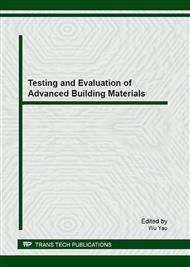[1]
P.C. Hewlett, Lea's Chemistry of Cement and Concrete. 4th ed., Oxford, Elsevier, 1998.
Google Scholar
[2]
T. Josef and H. Frank, Pore solution analysis of cement pastes and nanostructural investigations of hydrated C3S. Cement and Concrete Research, 33 (2003) 1063-1070.
DOI: 10.1016/s0008-8846(03)00011-5
Google Scholar
[3]
L. Barbara, Thermodynamic equilibrium calculations in cementitious systems, Materials and Structures, 43 (2010) 1413-1433.
Google Scholar
[4]
J.R. Eric, Problems and approaches to the prediction of the chemical composition in cement/water systems. Waste Management, 12 (1992) 221-239.
DOI: 10.1016/0956-053x(92)90050-s
Google Scholar
[5]
R. S. Barneyback and S. Diamond, Expression and analysis of pore fluids from hardened cement pastes and mortars, Cem. Concr. Res. 11 (1981) 279-285.
DOI: 10.1016/0008-8846(81)90069-7
Google Scholar
[6]
Mindess Sidney, Concrete, 1st ed., Prentice Hall, Englewood Cliffs, USA, 1981.
Google Scholar
[7]
D. K. Nordstrom, Groundwater Geochemistry, Springer-Verlag, The Netherlands, 2005.
Google Scholar
[8]
R. David, J. Jeffrey, B.J. Thomas, Solubility behavior of Ca, S, Al, and Si bearing solid phases in Porland cement pore solutions as a function of hydration time, Cem. Concr. Res. 32 (2002) 1663.
DOI: 10.1016/s0008-8846(02)00855-4
Google Scholar
[9]
D.L. Parkhurst, User's guide to PHREEQC- a computer program for speciation, reaction-path, advective transport, and inverse geochemical calculations, Water-Resources Investigations Report 95-4227,United States Geological Survey, Lakewood, CO, 1995.
DOI: 10.3133/wri954227
Google Scholar
[10]
K. Andersson,B. Allard,M. Bengtsson,B. Magnusson. Chemical composition of cement pore solution. Cement And Concrete Research,19 (1989) 327-332.
DOI: 10.1016/0008-8846(89)90022-7
Google Scholar
[11]
L. Barbara and W. Frank, Thermodynamic modeling of the hydration of Portland cement. Cement and Concrete Research,36 (2006) 209-226.
DOI: 10.1016/j.cemconres.2005.03.001
Google Scholar
[12]
H.M. Jennings. Aqueous solubility relationships for two types of calcium silicate hydrate. Journal of the American Ceramic Society,69 (1986) 614-618.
DOI: 10.1111/j.1151-2916.1986.tb04818.x
Google Scholar
[13]
E.M. Gartner,H. M. Jennings. Thermodynamics of Calcium Silicate Hydrates and Their Solutions. Journal of the American Ceramic Society,70 (1987) 743-749.
DOI: 10.1111/j.1151-2916.1987.tb04874.x
Google Scholar
[14]
E.J. Reardon. An ion interaction model for the determination of chemical equilibria in cement/water systems. Cement and Concrete Research,20 (1990) 175-192.
DOI: 10.1016/0008-8846(90)90070-e
Google Scholar
[15]
U.R. Berner. Evolution of pore water chemistry during degradation of cement in a radioactive waste repository environment. Waste Management,12 (1992) 201-219.
DOI: 10.1016/0956-053x(92)90049-o
Google Scholar
[16]
S. Börjesson, A. Emrén, C. Ekberg. A thermodynamic model for the calcium silicate hydrate gel, modeled as a non-ideal binary solid solution. Cement and Concrete Research, 11 (1997) 1649-1657
DOI: 10.1016/s0008-8846(97)00149-x
Google Scholar
[17]
M. Rahman, S. Nagasaki, and S. Tanaka. A model for dissolution of CaO-SiO2-H2O gel at Ca/Si > 1. Cement and Concrete Research, 29 (1999) 1091-1097.
DOI: 10.1016/s0008-8846(99)00092-7
Google Scholar
[18]
C.S. Walker, D. Savage, M. Tyrer. Non-ideal solid solution aqueous solution modeling of synthetic calcium silicate hydrate. Cement and Concrete Research, 37 (2007) 502-511.
DOI: 10.1016/j.cemconres.2006.12.002
Google Scholar
[19]
M. Kersten. Aqueous Solubility Diagrams for Cementitious Waste Stabilization Systems: I. The C-S-H Solid-Solution System. Environmental Science & Technology, 30 (1996) 2286-2293.
DOI: 10.1021/es950681b
Google Scholar
[20]
D.A. Kulik, M. Kersten. Aqueous solubility diagrams for cementitious waste stabilization systems: II, end-member stoichiometries of ideal calcium silicate hydrate solid solutions. Journal of the American Ceramic Society, 84 (2001) 3017-3026.
DOI: 10.1111/j.1151-2916.2001.tb01130.x
Google Scholar


